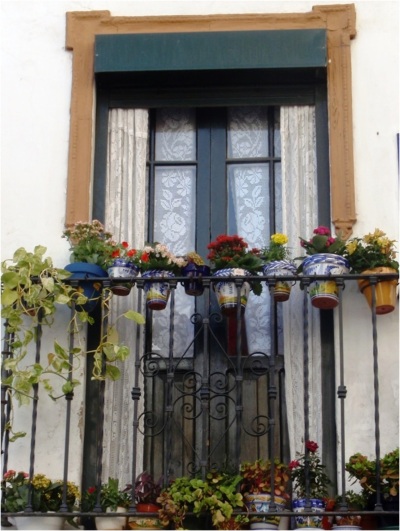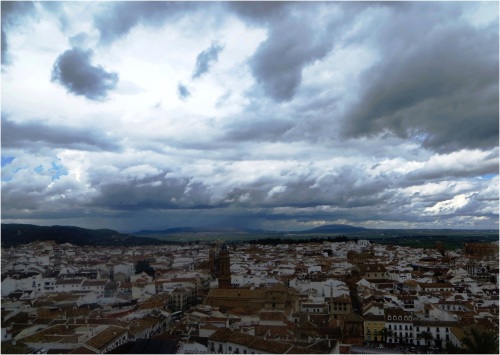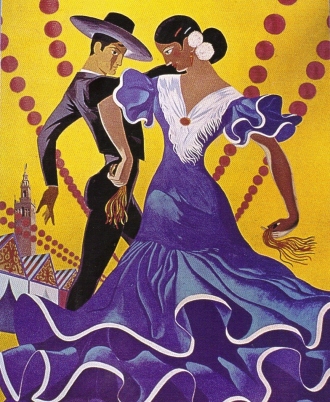If you are travelling to Spain and want to avoid the coast and the obvious tourist traps then let me make some suggestions…
Almagro in Castlla-La Mancha

“We are in the Spanish south. The castanets click from coast to coast, the cicada hum through the night, the air is heavy with jasmine and orange blossom… the girls have black eyes and undulating carriages.” – Jan Morris, ‘Spain’
Almagro is an old town that was once much more important than it is today, two hundred and fifty years ago it was for a short time the provincial capital of La Mancha (1750-61) but religious decline set in during the reign of Charles III and it fared badly and suffered damage in the Napoleonic and the Carlist wars. Eventually it was eclipsed by its neighbours, Ciudad Real and Bolaños de Calatrava and it became the quiet town that it is today on, not being unkind, a secondary, less important, tourist trail.
At a hundred metres long and forty metres wide the Plaza Major is one of the finest in all of Spain, flanked on both sides by arcades of cream Tuscan columns, weathered by the years, supporting overhead galleries all painted a uniform shade of botella verde and fully glazed in a central European style that makes this place truly unique in all of Spain. These galleries were originally open and used as grandstands for public events, religious festivals and even bullfights that were held here until 1785, when they were finally banned by King Carlos III.
Antequera in Andalucia

“For almost the first time I felt I was really in Spain, in a country that I had longed my whole life to visit. In the quiet back streets of I seemed to catch a momentary glimpse, a sort of far-off rumour of the Spain that dwells in everyone’s imagination.” – George Orwell
Antequera has always been an important place due its geographical position as it falls on a natural crossroads east/west between Seville and Granada and north/south between Malaga and Cordoba and the Moors built their most impregnable castle at this place to protect their possessions in Iberia.
Plaza San Sebastian is at the very bottom of the city at a busy roundabout junction where every major road in the city seems to converge, a bubbling pink marble water fountain, a modern monument that marks the junction of two Roman roads, a proud church, several grand buildings and overshadowed by the looming presence of the Alcazaba, a steep cobble-stoned hill climb away. The steps are steep but lead to the castle gate and inside is the Plaza de Santa Maria dominated by the biggest church in town.
Girona in Catalonia

“I would sooner be a foreigner in Spain than most countries. How easy it is to make friends in Spain!” – George Orwell
This is a fine place – better than Barcelona! The old town is packed onto a hillside alongside the river, which is spanned by a series of bridges that lead to the shopping area. One bridge leads to Carrer de la Força, which, it’s hard to believe was once part of the Via Augusta, the road that led across Spain from Rome, and from the tenth to the end of the fifteenth century was the main street of one of Europe’s most important Jewish quarters.
The visitor will climb all the time but make frequent and sometimes pointless diversions into side streets and blind alleys, up steep steps and along difficult cobbled passageways, always grateful for shade in this labyrinth of enchanting lanes.
Eventually everyone will arrive in the square in front of Santa Maria Cathedral whose Baroque façade conceals an austere Gothic interior that was built around a previous Romanesque church, of which the cloisters and a single tower remain. After the climb find the energy to climb the steps from the square to the Cathedral and go inside to visit the interior of the building and see the World’s widest Gothic nave and the second widest overall after St. Peter’s in Rome
Siguenza in Castilla-La Mancha

“…Sigüenza, ninety miles from Madrid, remains a quiet spot in an empty landscape. It sits among narrow valleys celebrated by Camilo José Celar in his ‘Journey to the Acarria’” – Christopher Howse – ‘A Pilgrim in Spain’
Sigüenza has always occupied an important strategic geographical position in a narrow valley on the main road and railway line between Madrid and Aragon and Catalonia. This is not a surprise, the Romans, the Moors and the Catholic Monarchs of the Reconquista had all previously fortified this place.
For a small town the cathedral is an immense building and one of the most important late Romanesque buildings in Spain which was built to symbolise the power of Bishop Don Bernardo who began construction in the twelfth century. It has three naves and a main chapel with an ambulatory and a dome and around the outer walls are a series of commemorative chapels which reads like a who’s who of the local campaigns of the Reconquista.
Inside is the jewel of the Cathedral, the Chapel of St. Catherine which houses the sepulchre of Martín Vázquez de Arce where in what is regarded as one of the finest examples of Spanish funerary art is his alabaster statue decorated with the cross of Santiago as he lies serenely on his side while casually reading a giant book. The authors of the Spanish Generation of 1898 (a group of patriotic artists and philosophers) drew national attention to the statue by naming him ‘el doncel de Sigüenza’ – the boy of Sigüenza.

In the Plaza Major café tables are arranged in the shadow of the South Tower which reaches high into the blue sky and has small-fortress like windows at regular intervals and the description fortress-like is rather appropriate because they bear the marks of shell damage inflicted on the building in 1936 during the Spanish Civil War.








































































